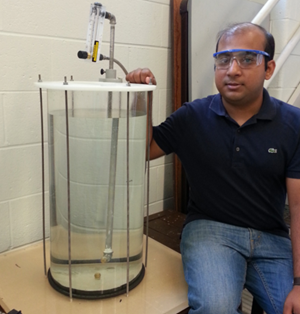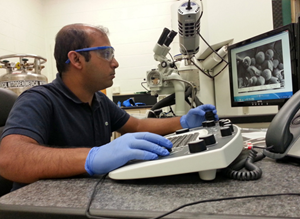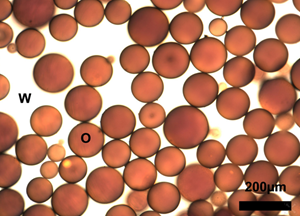
Amitesh Saha displays his setup to study the underwater injection of dispersant on an oil plume. (Provided by Saha)
Amitesh Saha is on a mission to find safer alternatives to dispersants currently being used in oil spill cleanup. His research is showing promising results that nanoparticle materials could not only replace dispersants but may also help the marine environment’s response.
Amitesh is a Chemical Engineering Ph.D. student at the University of Rhode Island (URI) and is a GoMRI scholar with C-MEDS. He tells us about his research and its impacts on his science and personal experiences.
His Path
At the time of the Deepwater Horizon oil spill, Amitesh was completing his master’s degree at URI and researching the basic use of particles to stabilize emulsions. However, the oil spill helped him realize that this fundamental science could be the foundation for an important application: oil cleanup. The topic piqued his interest because he felt that it could contribute to developing greener dispersants and stabilizing crude oil in seawater for containment purposes.
Based on his initial research results, Amitesh discussed this new direction with his advisor, Dr. Arijit Bose, who was considering an oil spill research proposal with Dr. Vijay John (Tulane University). After exploring environmentally benign particles as potential alternatives or supplements to conventional dispersants, Amitesh found strong evidence that carbon black particles could be used in oil spill mitigation. He presented the results to Bose who used them as their proposal’s basis. Their research became part of the larger C-MEDS grant focused on improving traditional dispersants and developing new alternatives. Bose also incorporated Amitesh’s work into another successful GoMRI grant led by URI.
His Work

Amitesh Saha uses a Cryogenic Scanning Electron Microscope to investigate the distribution of particles on an oil drop surface in an emulsion. (Provided by Saha)
Amitesh explains that dispersants can help expedite “nature’s way of cleaning an oil spill” as surfactants break crude oil into stabilized tiny drops such that they are suspended in the water column and consumed by oil-degrading bacteria. However, some surfactants do not form very stable emulsions and can be toxic to the marine environment, so Amitesh examined nanoparticles, and specifically carbon black, as an alternative. These nanoparticles form a shell around an oil drop, creating a more stable emulsion and reducing the transfer of harmful polycyclic aromatic hydrocarbons (PAHs) into water.
His results are showing the particles are not only environmentally benign, but also the shells they create also “provide a surface that supports the growth of hydrocarbon-eating bacteria,” Amitesh enthusiastically explains. He also found that nanoparticles are “compatible in both surface and subsea level applications.” His team is conducting experiments with carbon black particles that mimic different scenarios, such as in underwater injections and wave conditions.

A brightfield optical micrograph shows an emulsion of crude oil (O) in seawater (W) stabilized by carbon black particles. (Provided by Saha)
Amitesh says that the day he began working with crude oil samples from the Deepwater Horizon wellhead instead of substitutes laid the foundation for what he considers one of his greatest achievements so far. “For the first time, I was able to form a stable emulsion of crude oil in seawater using a very low concentration of carbon black particles.” These results proved the merit of carbon black for containing open-ocean oil spills. He happily reflects, “I remember clearly how excited Dr. Bose was when I told him about these results!”
Amitesh believes that the implications of his findings may significantly impact future oil spill responses, “We now know that carbon black particles can effectively emulsify oil in various conditions. This shows the potential of nonconventional materials as dispersants.” The GoMRI website featured asummary about their published research in Applied Materials & Interfaces and in Langmuir.
His Learning
Amitesh says that his work with C-MEDS has been a learning experience filled with new opportunities, such as using Cryogenic Scanning Electron Microscopy at Tulane University. For two weeks, the Tulane team trained him, and together they conducted experiments using the instrument to analyze how particles covered oil drops. Being able to visualize this process helped “catapult” him towards new research methods. Amitesh also saw the effects of using seawater rather than plain water in their experiments, “Salts in seawater helped our particles form stable emulsions, showing their ease of delivery in the event of an oil spill.” He brought this knowledge back to his team, set up their own Cryogenic Scanning Electron Microscopy, and incorporated it into their experiments.
Amitesh has learned a great deal about the scientific community through C-MEDS, “I have had the opportunity to collaborate with some of the smartest, most experienced people in my field.” Interacting with scientists in different fields also improved his research, “It’s really wonderful – it widens your horizon; you look at problems in a different light, giving you a better understanding of the problems you are trying to solve.”
His Future
Obtaining successful results in his first graduate project has led Amitesh to truly “fall in love” with his work. He has seen that particles have great application potential. With this framework set, he says that “it’s just a matter of time before we see many sides of using nanoparticles to solve problems.” Amitesh sees himself as a research scientist in industry or academia, using the experience and knowledge he has honed over the years to solve real-world problems. “I look forward to using my skills to the fullest!”
Praise for Amitesh
Dr. Bose speaks highly about Amitesh’s positive and enthusiastic personality and his skills as a scientist, “His can-do approach was critical towards demonstrating this new oil emulsification concept. He is highly creative, hardworking, and always ready to take on new challenges.” Bose added that Amitesh conducts his work with “grace and good humor, qualities that will really help him as he moves on to the next phase of his professional life.”
The GoMRI community embraces bright and dedicated students like Amitesh Saha and their important contributions. TheGoMRI Scholars Program recognizes graduate students whose work focuses on GoMRI-funded projects and builds community for the next generation of ocean science professionals.
Visit the C-MEDS website to learn more about their work.
************
This research was made possible in part by a grant from BP/The Gulf of Mexico Research Initiative (GoMRI) to theConsortium for the Molecular Engineering of Dispersant Systems (C-MEDS). The GoMRI is a 10-year independent research program established to study the effect, and the potential associated impact, of hydrocarbon releases on the environment and public health, as well as to develop improved spill mitigation, oil detection, characterization and remediation technologies. An independent and academic 20-member Research Board makes the funding and research direction decisions to ensure the intellectual quality, effectiveness and academic independence of the GoMRI research. All research data, findings and publications will be made publicly available. The program was established through a $500 million financial commitment from BP. For more information, visit http://gulfresearchinitiative.org/.
